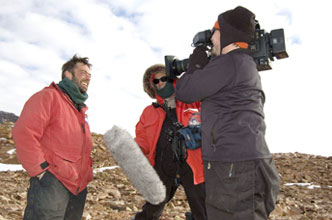Antarctica’s last stand of life: unprecedented fossil finds grant new insight into the continent’s natural history
Fossil finds grant new insight into the Antarctica’s natural history
Jeremy Hance, mongabay.com
August 7, 2008
|
|
When Antarctica used to be green
At one time an alpine lake was inhabited by mosses and diatoms; insects such as beetles and midges crawled among sparse ferns and various crustaceans lived amid the lake’s calm waters. This tundra-like landscape was the last stand of life in Antarctica, and it existed up to 14 million years ago before suddenly vanishing.
David Marchant, an associate professor of earth sciences at Boston University, has been traveling to the McMurdo Dry Valleys of Antarctica since 1986 but only recently a member of his team, Adam Lewis, stumbled upon the find of a lifetime: incredibly well-preserved fossils of mosses, ferns, insects, crustaceans, and diatoms near a dry lake-bed. As the name suggests, the Dry Valleys are entirely ice-free and barren of all life. But the fossil-find proves that life once existed here.
“The fossil finds allow us to examine Antarctica as it existed just prior to climate cooling at 13.9 million years ago. It is a unique window into the past. On land, there are very few places on Earth that contain sediment of this age, and none are as well preserved as those found in the Dry Valleys,” Marchant said. “The sediments allow reconstructions of alpine glaciers, tundra and lakes, all in remarkable detail. To study these deposits is akin to strolling across the Dry Valleys 14.1 million years ago.”
 David Marchant is interviewed in the McMurdo Dry Valleys. Credit: NSF photo |
The dry cold climate of Antarctica has created some of the best preserved fossils from this period anywhere in the world. Amid the mosses, small ostrocods rest; these tiny crustaceans are rarely found in the fossil record with their soft parts preserved. The fossils are the “first to be found even though scientific expeditions have been visiting the Dry Valleys since their discovery during the first Scott expedition in 1902-1903,” said Adam Lewis who is now a geoscientist at North Dakota State University.
The fossils are not only surprising for their life-like preservation. The scientists have also described that some of the species are nearly identical to modern ones. The most prevalent moss fossil appears to be an exact replica of a contemporary bryophyte, Drepanocladus longifolius. The scientists find such a discovery startling.
“To be able to identify living species amongst the fossils is phenomenal. To think that modern counterparts have survived 14 million years on Earth without any significant changes in the details of their appearances is striking. It must mean that these organisms are so well-adapted to their habitats that in spite of repeated climate changes and isolation of populations for millions of years they have not become extinct but have survived” said Allan Ashworth, the paleoecologist of the team.
From Terra del Fuego to Mars
What happened to this greener Antarctica? Unknown reasons caused temperatures to plummet in this area of Antarctica making life unsustainable. Marchant says that “everything about the fossil site, from its geology to the fossils themselves, tells us the climate shift was abrupt, major, and enduring. Its legacy continues to this day… It is one of the most dramatic and long-lasting changes that one can imagine,” he continues. “I don’t know of any other place on Earth where such an enduring change has been documented; the fact that it is associated with the extinction of tundra plants and insects helps provide quantitative estimates for the magnitude of this change.”
 Examples of fossils found in the McMurdo Dry Valleys. Credit: Zina Deretsky/National Science Foundation |
These are the first fossils from Antarctica whose age is able to be determined. To do so—and therefore discover the time at which the region became uninhabitable—the team employed a variety of techniques including computer modeling, paleoecology, studying volcanic ash, and glacial geology. The team now believes that around 14 million years ago the region underwent a massive shift, dropping a mean average of 8 degrees Celsius (14.4 degrees Fahrenheit). Summer temperatures may have been as much as 17 degrees Celsius warmer than summers now in the Dry Valleys.
“To me the most interesting part of the whole story is that we’ve documented the timing and the magnitude of a tremendous change in Antarctic climate: the transition marks a shift from warm, temperate glaciers with patches of fringing tundra to today’s cold-polar glaciers set within in a barren polar desert,” said Marchant. “The contrast couldn’t be more striking. It is like comparing Tierra del Fuego today with the surface of Mars–and this transition took place over a geologically short interval of roughly 200,000 years.”
The causes of this climatic shift remain a mystery. Marchant, in an interview with the National Science Foundation, said “in terms of what caused this change, that’s the sixty-four thousand dollar question”. Two possibilities include large-scale changes in ocean circulation or a decline in atmospheric CO2.
Tom Wagner, program director for Antarctic Earth Sciences, concludes that “Lewis, Marchant and Ashworth discovered the last bit of life on the Antarctic continent. It was hanging on by its fingernails–just a few simple plants and bugs in a small pond, everything else around them frozen over–and then, wham!, they went too. And it must have happened quickly because these fossils are literally freeze dried. When I visited the scientists in the field, they showed me how the moss was still green and leafy.”
The scientists hope to use this discovery to further understand current climate change and its implications.